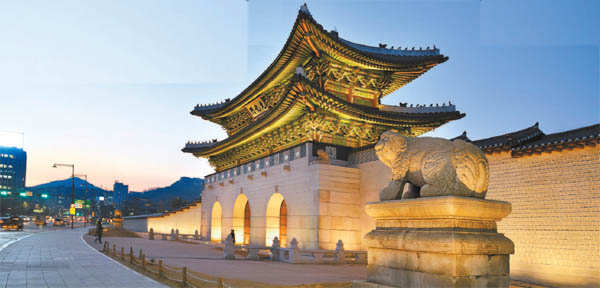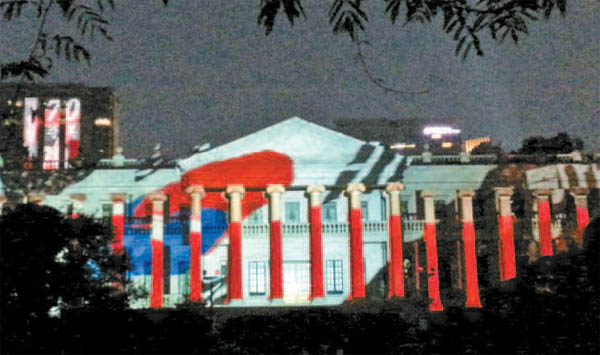Celebrate Liberation Day with events across Seoul

Gyeongbok Palace in central Seoul, where visitors view the historic structures at night. Provided by the organizer
But despite the ongoing tumult on the peninsula, this year’s 70th anniversary of Liberation Day is cause for celebration. Many art galleries, museums and performance venues in Seoul have prepared a variety of cultural events for the public to mark the painful yet joyous memory of this special day with family and friends.
The Korea JoongAng Daily has chosen some of these events to highlight below.
EVENTS
As this year’s Liberation Day has special significance as the 70th anniversary, the Cultural Heritage Administration (CHA) has prepared various events that allow the public to experience historical heritage.

The media facade projected onto Seokjojeon at Deoksu Palace in central Seoul. Provided by the organizer
The performances range from seonyurak, a dance that originated from the boat parties that Silla Dynasty (56 B.C. to A.D. 935) aristocrats enjoyed, to ogomu, commonly known as the five drums dance.
The festival, which runs until Saturday, is happening during the Gyeongbok Palace Night Tour. The showcase starts at 8 p.m. The performances are free but nighttime admission costs 3,000 won ($2.50).
Another interesting event is being held at Seokjojeon, a stone building located inside the grounds of Deoksu Palace in central Seoul. Directed by Yonsei University Prof. Kim Hyung-soo, the show features a media facade that projects images onto the outside of the building. The 12-minute show, which runs through Saturday, demonstrates the historical significance of Seokjojeon and the 70th Liberation Day with dazzling visual effects and stereophonic sound. The show starts at 8 and 8:30 p.m. and is free of charge.
Deoksu Palace Pungnyu is another event happening in Deoksu Palace. The traditional gugak (Korean traditional music) nighttime performances began in 2010, but the upcoming show holds a special meaning in that it marks the 100th performance.
To celebrate the special event, organizers have invited several renowned Korean traditional artists, including Lee Saeng-kang, who plays the daegeum (horizontal bamboo flute), and one of the greatest pansori (Korean traditional opera) singers, Ahn Sook-sun. The performance will take place on Aug. 20 at Deoksu Palace’s Hamnyeongjeon Hall, the former sleeping residence of King Gojong (1852-1919). The showcase begins at 7:30 p.m. and is free of charge.
For more information about the events above, visit www.cha.go.kr.
The CHA has also prepared a series of lectures by cultural specialists, set to take place at the Jeonggwanheon Pavilion at Deoksu Palace. The public is invited to attend lectures by various authors, who will discuss issues such as literature, fashion, history, films and pop music, based on their published works.
In addition to the talks, a concert by the ensemble of Park Kyung-hoon will also be staged during the lectures, which run from Aug. 25 to 26 and also from Aug. 28 to 30.
Those interested in attending must sign up in advance through www.chf.or.kr. All lectures start at 7 p.m., and admission is free.
EXHIBITIONS
Tensions between North and South Korea have soared recently after South Korean soldiers were severely injured by land mines installed by the North Korean Army at the highly fortified border. Despite that incident, many Korean citizens still yearn for the unification of the two Koreas, a wish demonstrated in the exhibition “NK Project” at the Seoul Museum of Art.

Left: An oil painting on display in the “NK Project” exhibit. Provided by the organizer Right: Media artist Jeon Jun-ho’s “Hyper Realism ? Two Brothers,” on display at “Uproarious, Heated, Inundated.” Provided by the organizer
“Namsan Mountain, the Power of Place” is another interesting exhibition happening at the Seoul Museum of History. Located in the heart of the city, Mount Namsan has often been perceived as the symbol of Seoul ever since the city’s designation as Korea’s capital in 1392. The exhibit, which runs through Nov. 1, showcases the changing historical meanings of the mountain during the Japanese colonial era and the subsequent Korean authoritarian regimes through 250 pieces of artwork. For more information, visit www.museum.seoul.kr.
For a look at more recent Korean history, the National Museum of Modern and Contemporary Art’s Seoul branch is holding an exhibition titled “Uproarious, Heated, Inundated.” Each of the exhibition’s three sections tells the story of a different time period through visual art. The first part, “Uproarious,” covers the 1950-53 Korean War and life in postwar Korea. The second section, “Heated,” focuses on the period between the 1960s and the 1980s, during which Korea underwent rapid industrialization and urbanization. And the last section, “Inundated,” examines Korean society since the 1990s. The historic exhibition includes 270 pieces by 110 artists and it will run through Oct. 11. For details, visit www.mmca.go.kr.
CONCERTS
For those who wish to celebrate this special day with music, one option is a concert by famous musician Seo Taiji. Often dubbed as the president of culture, the 43-year-old will hold concerts to celebrate the 70th anniversary of Liberation Day on both Saturday and Sunday. The event will take place at Yes24 Muv Hall in Mapo District, western Seoul.
Seo, who recently played at last week’s Incheon Pentaport Rock Festival, has many of his fans wondering whether these shows will be just as good as the one he held last week. After staging concerts to celebrate previous Liberation Days in 2008 and 2009, Seo is said to be planning a surprise performance that his fans haven’t seen before for this year’s event. The shows start at 6 p.m. Tickets cost 88,000 won and are available at ticket.yes24.com.

Left: A singer performs “Arirang” during Hwahee Opera Company’s concert last year. Provided by the organizer Right: The National Orchestra will stage a performance Saturday at 4 p.m. at the National Theater of Korea. Provided by the organizer
No matter who sings it, Kang Yoon-soo, the artistic director of Hwahee Opera Company, says the song is sure to evoke an emotional response from listeners. As part of the Ministry of Culture, Sports and Tourism’s schedule of organized performances for the 70th anniversary of Liberation Day, Hwahee Opera Company will hold its third Peace Music Concert at 5 p.m. on Sunday at the Grand Theater of the Sejong Center for the Performing Arts.
During the concert, singers from seven different countries will each appear to perform gagok, a genre of Korean vocal music that combines emotional and poetic lyrics with instrumental accompaniment, including the famed “Arirang.” The concert starts at 5 p.m. Tickets range from 30,000 won to 200,000 won. For more information, visit www.sejongpac.or.kr.
The National Orchestra of Korea is also preparing a performance of “Arirang,” at the National Theater of Korea on Saturday. This orchestra consisting of traditional Korean instruments will play different versions of the folk song, including “Arirang Fantasia” and “Namdo Arirang.”
Then, singers will join the orchestra for the second half of the performance and together perform additional variations of the song. The concert starts at 4 p.m., and tickets cost 10,000 won. For more information, visit www.ntok.go.kr.
BY YIM SEUNG-HYE, JIN MIN-JI [jin.minji@joongang.co.kr]










with the Korea JoongAng Daily
To write comments, please log in to one of the accounts.
Standards Board Policy (0/250자)